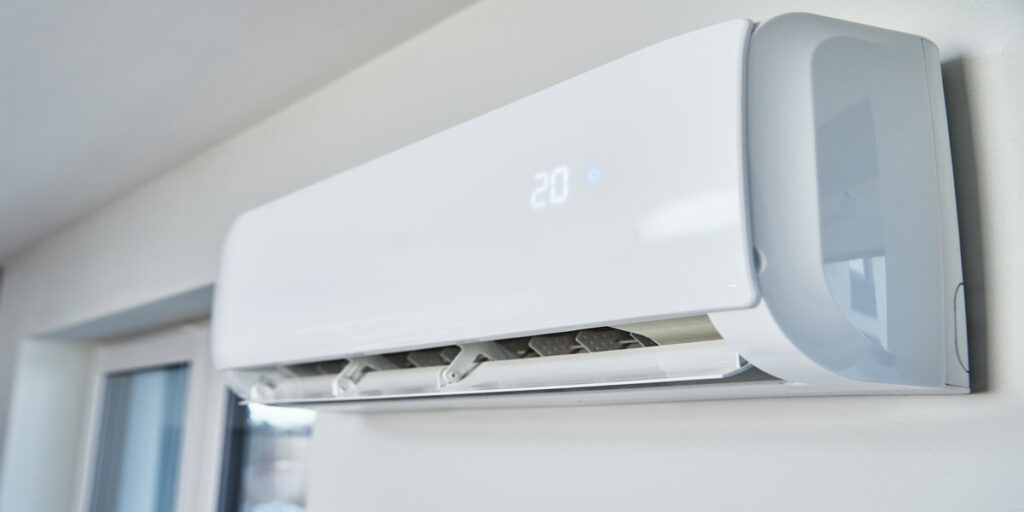We all know the feeling of relief when we step inside a comfortably air-conditioned building on a blistering summer day. The average layperson may assume that air conditioners generate cold air and blow it into space. However, air conditioners extract indoor heat and transfer it to the outdoors through a fairly complex process known as a refrigeration cycle.
Simply put, the purpose of the refrigeration cycle is to absorb and reject heat. While there are myriad heating and cooling systems on the market today, the basic function of an air conditioning cycle remains the same regardless of where you are in the world and across various industries.
How does an air conditioner cool an indoor space? The cycle starts by extracting hot indoor air and passing through a cooling agent called a refrigerant. The components within the air conditioner manipulate the refrigerant’s temperature, state, and pressure to reject or absorb heat at specific points. The AC air handler releases hot air outside and distributes the cooled air into the room through a series of ducts. The process repeats.
This article provides a detailed overview of the process and science behind an air conditioning cycle. When you have questions or require the services of an effective HVAC contractor in Douglassville, PA, contact the Topline Heating & Air team.
The Importance of Refrigerant
Refrigerants are the magic ingredient of air conditioning systems. AC refrigerant is vital to the cooling process. The refrigerant travels through the components of the system by way of the condenser coils, absorbing hot air and converting it into cooled air in conjunction with the other parts of the air conditioning system. The colder the refrigerant, the greater its ability to absorb heat and cool the air. Many refrigerants exist, most of which tend to be equally effective.
Even though refrigerant is in a perpetual state of change—from evaporated low-pressure gas to a liquified chemical compound—refrigerant remains always contained within the air conditioning system. Because handling refrigerant directly is hazardous to your health, it requires an expert touch.
The Four Components of an Air Conditioner
Four components of the air conditioning cycle work together to determine when and where the refrigerant absorbs or releases heat, helping your air conditioner cool your home.
These components include:
• Compressor
• Condenser
• Expansion device
• Evaporator
Compressor
The compressor, in a sense, is the heart of the air conditioner. Its job is to circulate the refrigerant as needed through a closed system of coils. A cooling system requires high pressure to be effective, so the cooling process starts with the compressor.
The compressor manipulates the refrigerant to create vapor or hot liquid as needed. Without the compressor, the refrigerant would sit in the AC system without moving.
Condenser
Air conditioning is made possible by transferring heat from the refrigerant to the outdoor air. The refrigerant absorbs heat from indoors to eventually dissipate into the outdoors. The relationship between the compressor and condenser is an integral part of the process.
The pressurized gas refrigerant exits the compressor and moves into a network of pipes known as the condenser. The condenser takes in high pressure and hot gas refrigerant before manipulating the ratio of pressure and temperature through a network of coils. The condenser coils expel hot air from the house. Upon leaving the compressor and entering the condenser, the gas refrigerant loses heat and liquefies.
Expansion Device
The liquid refrigerant leaves the condenser unit at a very high temperature. The refrigerant must be at a lower temperature to be able to absorb heat from the indoor air. A metering device, such as a thermostatic expansion valve or capillary tube, will reduce the pressure of the hot refrigerant, causing it to slow down, drop in temperature, and expand in volume.
The thermal expansion valve is adaptive, while a fixed orifice or capillary tube provides measured expansion by narrowing the speed of the refrigerant. Either way, its function is to meter the cooling liquid refrigerant into the evaporator. The expansion device is the divider between the system’s high-pressure and low-pressure elements.
The cooled refrigerant will flow into the evaporator coils, repeating the refrigeration cycle.
Evaporator
The evaporator and condenser serve opposite functions. Where the condenser turns the refrigerant from gas to liquid, the evaporator turns liquid refrigerant into gas. The evaporator absorbs heat and removes humidity when the refrigerant enters the evaporator’s metering device. The evaporator changes the temperature of the refrigerant by changing the pressure. It then absorbs the heat and cools the air by “conditioning” it, hence the term “air conditioning.”
When humid air comes into contact with the cold coils, the water vapor alters its state to liquid, a process known as condensation. The evaporator transforms the liquid refrigerant into a gas, forcing it to absorb the heat of the surrounding air, cooling the space.
A New Cycle Begins
Upon leaving the evaporator, the gas refrigerant moves back into the compressor, where the air conditioning cycle repeats.
A well-maintained air conditioner will cycle two or three times per hour for 15 to 20 minutes. The exact run times vary depending on the time of year, climate, outdoor and indoor temperature, and indoor air quality.
Contact Us
Hopefully, this article has shed some light on the principles and operation of an air conditioning cycle. There are several moving parts that must work in conjunction to cool your home efficiently and consistently. In the case of an AC malfunction, any of these components could be the culprit.
That’s why it makes sense to contact a professional at the first sign of trouble with your air conditioning cycle. When you need the assistance of a professional HVAC contractor, contact the experts at Topline Heating & Air. We strive to deliver best-in-class heating and cooling solutions to the residents of Douglassville, PA, and the surrounding areas.
Call us at (717) 628-6825 to set up a consultation, or keep reading if you want to know more about HVAC systems ratings.



